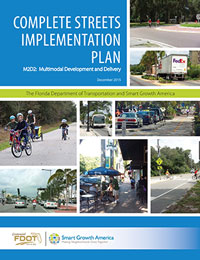AARP Hearing Center
The 2011 Dangerous by Design Report by the National Coalition of Complete Streets ranked four Florida metropolitan areas among the most dangerous in the nation for pedestrians. The poor marks inspired the Florida Department of Transportation (FDOT) to take a look at itself and the state's car- and truck-oriented transportation network.
Working in partnership with Smart Growth America, FDOT released Complete Streets Implementation Plan M2D2: Multimodal Development and Delivery, a report outlining the state's strategy for how to disappear from the dangerous list.


A key outcome of the work was Florida's adoption in 2014 of a statewide Complete Streets policy that states:
"… the Department will routinely plan, design, construct, reconstruct and operate a context-sensitive system of 'Complete Streets.' While maintaining safety and mobility, Complete Streets shall service the transportation needs of transportation system users of all ages and abilities, including but not limited to: cyclists, freight handlers, motorists, pedestrians, and transit riders."
As part of the state's effort to make its roads friendlier to pedestrians and bicyclists, the FDOT has to make its internal procedures and documents friendlier to actually getting work done.


Walking the Talk
Interview: 5 Questions about Complete Streets for Florida Transportation Secretary Billy Hattaway
Because of that, the plan calls for changing FDOT's decision-making processes. It provides recommendations such as integrating Complete Streets policies into FDOT's long-range plans and aligning decision-making criteria with a Complete Streets approach.
The implementation plan outlines a five-part framework that provides strategies and recommendations for how key standards, manuals, procedures, policies, guides, reports and other documents can be revised to reflect Complete Street policies.
Key elements of the two-year implementation plan include:
- Revising guidance, standards, manuals, policies and documents
- Updating decision-making processes
- Modifying approaches for measuring performance
- Managing internal and external communication and collaboration
- Providing ongoing education and training
A table that starts on page 8 lists the documents that need to be revised in some way in order to adhere to a Complete Streets approach:
"Integrating a Complete Streets approach into the documents used to guide daily decisions across programs will be a crucial step in successfully aligning FDOT's practices with the objectives of the Complete Streets Policy," the authors explain. "The FDOT has a wealth of guidance and research in place already that can support Complete Streets implementation, but much of it has not yet been integrated directly into decision-making on a large scale because the core documents that influence planning, programming, project development, design and operations on a daily basis do not reflect the findings."
For a state that developed and grew during the car-centric decades of the 20th century, there's a lot to do and undo. But the plan for moving forward is a good one, says Jana Lynott, a land-use and transportation planner who is a senior strategic policy adviser with the AARP Public Policy Institute: "The Florida Complete Streets Implementation Plan is a well thought out approach to ensuring the state's roads are designed, built and maintained with all users in mind. This is essential for improving the safety of Florida's 3.6 million road users over the age of 65 who are currently over-represented in fatal crashes, in particular those involving older pedestrians."
The final phase of the two-year timeline, slated for January 2018, proposes evaluating accomplishments and determining next steps.
Page published July 2016 | Summary by Laura Cantwell
You May Also Like
- Visit our Complete Streets archive
- Check out Smart Growth America's 2014 Dangerous By Design Report
- Watch the AARP slideshow "Dangerously Incomplete Streets"
- Read the AARP Livability Fact Sheets


























































